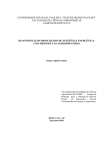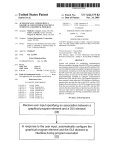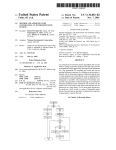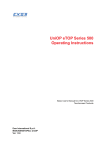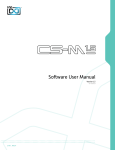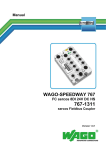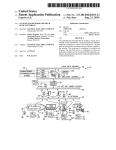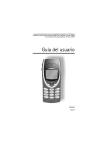Download Graphical programming system with distributed block diagram
Transcript
US006802053B1 (12) United States Patent Dye et al. (54) GRAPHICAL PROGRAMMING SYSTEM WITH DISTRIBUTED BLOCK DIAGRAM EXECUTION AND FRONT PANEL DISPLAY (75) Inventors: Robert E. Dye, Austin, TX (US); Darshan Shah, Round Rock, TX (US); Steve Rogers, Austin, TX (US); Greg Richardson, Round Rock, TX (US); Dean A. Luick, Austin, TX (US) (73) Assignee: National Instruments Corporation, Austin, TX (US) Notice: US 6,802,053 B1 (10) Patent N0.: (45) Date of Patent: Subject to any disclaimer, the term of this patent is extended or adjusted under 35 U.S.C. 154(b) by 518 days. (21) Appl. No.: 09/617,600 Jun. 13, 2000 (22) Filed: Related US. Application Data Oct. 5, 2004 FOREIGN PATENT DOCUMENTS EP EP EP W0 W0 W0 0 367 709 0 398 646 0 426 909 W0 94 10627 A W0 94 15311 A W0 96 14618 A 5/1990 11/1990 5/1991 5/1994 7/1994 5/1996 OTHER PUBLICATIONS Shaheen et al., “Remote Laboratory Experimentation”, IEEE, Proceeding of American Control Conference, pp.:1326—1329 Jun. 1998* Gillet et al., “Telepresence: An Opportunity to develop Real—World Experimentation in Education”, CiteSeer, pp.:1—6, 1997.* Johnston et al., “High—Speed Distributed Data Handling for On—Line Instrumentation Systems”, Lawrence Berkeley National Laboratory, pp.: 1—19, Aug. 1997.* (List continued on next page.) Primary Examiner—Wei Y. Zhen Assistant Examiner—Ted T. V0 (74) Attorney, Agent, or Firm—Meyertons Hood Kivlin KoWert & GoetZel, P.C.; Jeffrey C. Hood (63) (60) Continuation-in-part of application No. 08/912,445, ?led on Aug. 18, 1997, now Pat. No. 6,173,438. Provisional application No. 60/149,950, ?led on Aug. 19, 1999. (57) (51) (52) Int. Cl.7 ................................................ .. G06F 9/44 System and method enabling client computer(s) to connect US. Cl. ..................... .. 717/113; 717/109; 717/127; to a server Computer and receive a graphical program user 345/740 interface panel(s) for providing input to and/or displaying (58) Field of Search ............... .. 717/104_115, 124_131, Output from the graphical program, thereby Comprising a 717/162_178; 709/217_225; 345/619, 650, distributed virtual instrumentation system, Wherein a block 734_743, 661, 676, 689, 47()_471, 762_765, 20_24, 965_968 References Cited diagram executes on a server computer to perform a mea surement or automation function, and the panel(s) is/are displayed on the client computer(s), enabling users to remotely vieW and/or control the function. The user may U'S' PATENT DOCUMENTS specify the server, i.e., by entering a URL into a Web broWser (56) 4,827,404 A ABSTRACT and may also specify the graphical program desired. The user interface panel may be dynamically updated during 5/1989 Barstow et al. 4,849,880 A 7/1989 Bhaskar et al- execution of the program. The user may interact With the 47901221 A 2/1990 KPdOSkY ct a1~ panel on the client computer to provide input to the graphical 5,109,504 A 4/1992 Little'ton ................... .. 395/500 program executing on the Server, and may also request and 5309556 A 5/1994 Slsmlhch receive a block diagram for the remote graphical program 5,377,318 A 5,437,464 A 12/1994 Wolber . 8/1995 Terasima et al. ............ .. 463/43 . 6%" to “W and/0r remotely ed“ the Program" (List continued on next page.) 162 Claims, 10 Drawing Sheets _——l ueer epeptl‘m I lemme ppmwuler running a graphical program 450 1 user‘: clienl sullwure mail/e: data updalel lrurrr the 15mm: mprner Ind updates the user lrrtemrpe panel(s) an the users display melt Q urer lpeci?el u gl-Iphical prqrlm running on the rempte wrrrpuler 5:52 ulet pperane: user interface panel(s) In control the griphical 1 were client mule connects to the remote computer m 1 men cllsllt lOMrG rlqlleau me lrrer lmemim panel ductlpm'orKs) 01th! user interface panel(l) iiwclited with me ?l'lphiml awn iii 1 user‘: cliorlt wltwrrre receive: the tleer lrrlemrpe panel deucriptloms) (mm the remote eqmprrler me d'lspletys the user lmelme panel(s) an the Ll!!!“ dlaplsy screen as nmrarrr 5&2 ’ US 6,802,053 B1 Page 2 US. PATENT DOCUMENTS 5,481,740 A 5,497,498 A 5,535,342 A 1/1996 Kodosky 3/1996 Taylor 7/1996 Taylor 5,541,849 A 7/1996 Rostoker et al. 5,555,201 A 9/1996 Dangelo et al. 5,566,295 A 10/1996 Cypher et al. ............ .. 345/326 5,583,749 A 12/1996 Tredennick et al. 5,603,043 A 5,638,299 A 2/1997 Taylor et al. 6/1997 Miller 5,652,875 A 5,652,909 A 7/1997 Taylor 7/1997 Kodosky 5,684,980 A 11/1997 Casselman 5,724,074 A 3/1998 Chainani et al. .......... .. 345/474 5,732,277 A 3/1998 Kodosky et al. 5,737,235 A 4/1998 Kean et al. 5,760,788 A 5,784,275 A 6/1998 Chainani et al. .......... .. 345/475 7/1998 Sojoodi et al. ........... .. 364/191 5,801,689 6,064,409 6,173,438 6,219,628 6,226,776 6,230,307 9/1998 5/2000 1/2001 4/2001 5/2001 5/2001 A A B1 B1 B1 B1 Huntsman Thomsen et al. Kodosky et al. Kodosky et al. Panchul et al. Davis et al. OTHER PUBLICATIONS Weban, A.; BroWn, G. “A Software Development System for FPGA—based Data Acquisition Systems”, FPGAs for Cus tom Computing Machines, 1996. Beguelin et al., “Visualization and Debugging in a Hetero geneous Environment”, IEEE, Jun. 1993, pp 88—95. Jamal et al., “The Aplicability of the Visual Programming Language LabVIEW to Large Real—World Application”, IEEE, 1995, pp 99—106. Per—Arne Wiberg, “Graphical Programming of Time—Deter ministic Real—Time Systems”, IEEE, 1996, pp 173—180. Ade, M; LauWereins, R; Peperstraete, J .A.; HardWare—Soft Ware Codesign With GRAPE, Proceedings of the Sixth IEEE International Workshop on Rapid System Prototyping, Jun. 9, 1995, pp. 40—47. LauWereins, R; Engels, M; Ade, M; Peperstraete, J; Grape—II: A System—Level Prototyping Environment for DSP Applications, Computer, vol. 28, Issue 2, 2/95, pp. 35—43. Labrosse, Jean, “Inside Real—Time Kernels,” Conference Proceedings of Embedded Systems Conference East, Mar. 10—12, 1997, Boston, Massachusetts, pp. 205—214. Labrosse, Jean, “Designing With Real—Time Kernels,” Con ference Proceedings of Embedded Systems Conference East, Mar. 10—12, 1997, Boston, Massachusetts, pp. 379—389. Operating Systems, 2”“ Ed. By Williams Stallings, Prentice Hall, 1995, “Multiprocessor and Real—Time Scheduling”, pp. 394—415. XP000554820 EdWards, et al., “SoftWare acceleration using programmable hardWare devices,” IEEE Proceedings: Com puters and Digital Techniques, vol. 143, No. 1, Jan. 1996, pp. 55—63. XP000380758 Lesser, et al, “High Level Synthesis and Generating FPGAs With the BEDROC System,” Journal of VLSI Signal Processing, vol. 6, No. 2, Aug. 1993, pp. 191—214. International Search Report for PCT/US 98/13040 mailed Dec. 22, 1998. “LabVIEW User Manual for Windows”, National Instru ments Co., Sep. 1994 pp. 4/1—21. International Search Report for PCT/US 98/10916 dated Sep. 17, 1998. Douglas, Bruce D., Ph.D., Custom Embedded Communica tion Protocols, Conference Proceedings of Embedded Sys tems Conference East, Mar. 10—12, 1997, Boston, Massa chusetts, pp. 637—657. International Search Report, Application No. PCT/US 00/22317, mailed Dec. 19, 2000. SPW/CGS Porting Kits Product Data Sheet, 11/94, 2 pages. MultiProX for SPW Product Data Sheet, 08/94, 4 pages. DSP ProCoder for SPW Product Data Sheet, 11/94, 4 pages. Xanalog Corporation Sales Manual, Jan. 1987, 8 pages. Available XA—1000 Literature and Its Use, 1986, 2 pages. Xanalog, XA—1000 Programming ICONS, 1986, 26 pages. Xanalog’s CAE System: The Fastest AT Alive, Mass High Tech, vol. 4, No. 22, Aug. 1988, 1 page. Xanalog The Computer Aided Engineering Workstation Comes to Simulation, Simulation vol. 47, No. 1, Jul. 1986, 3 pages. Xanalog RT Real Time Analog and Digital I/O, 10/90, 4 pages. Xanalog/SC+, 9/90, 4 pages. Xanalog Specializing in Workstations for Continuous Dynamic Simulation, 1987, 24 pages. Xanalog Real—Time User Guide, 1994, 28 pages. Lee et al., “Gabriel: A Design Environment for Program mable DSPs”, Nov. 7, 1988, 13 pages. Lee et al., “A Design Tool for HardWare and SoftWare for Multiprocessor DSP Systems”, May 1989, 4 pages. Gabriel 0.7 OvervieW, 1990, 5 pages. Joseph T. Buck and EdWard A. Lee, “Scheduling Dynamic Data?oW Graphs With Bounded Memory Using the Token FloW Model”, http://WWW.synopsys.com/, 1995, 4 pages. EdWard A. Lee, “Design Methodology for DSP”, 1992, 4 pages. Pino et al, Interface Synthesis in Heterogeneous System— Level DSP Design Tools, May 1996, 4 pages. Jose Luis Pino, Master’s Report, “SoftWare Synthesis for Single—Processor DSP Systems Using Ptolemy”, May 1993, 48 pages. AsaWaree Kalavade and EdWard A. Lee, “A HardWare—Soft Shearman, Sam, Assoc. Editor, “HardWare—in—the—loop connectivity extends continuous—system simulation”, Per Ware Codesign Methodology for DSP Applications”, 1993, sonal Engineering, Jun. 1997, pp. 18—37. XP0002087124 Xiao—Yu, et al., “SotWare Environment for Pino et al., “Automatic Code Generation for Heterogeneous WASMII: AData Driven Machine With a Virtual HardWare,” Tool Chest continues to GroW, Electronic Engineering Times, Dec. 15, 1995, 2 pages. Field Programmable Logic Architectures, Synthesis and Applications, 4”1 International Workshop on Field—Program mable Logic and Applications, FPL ’94 Proceedings, Berlin, Germany, 1994. 12 pages. Multiprocessors”, 1994, 4 pages. Pino et al., Mapping Multiple Independent Syunchronous data?oW Graphs onto Heterogeneous Multiprocessors, Oct. 1994, 6 pages. US 6,802,053 B1 Page 3 Asawaree Kalavade and Edward A. Lee, Hardware/Software Collamati et al. “Induction Machine stator Fault On—line Co—Design Using Ptolemy—A Case Study, 09/1992, 18 Diagnosis Based on LabVIEW Environment”, Mediterra nean Electrotechnical Conference, vol. 1, p. 495—498, May pages. Pino et al, “Software Synthesis for DSP Using Ptolemy”, 1995, 15 pages. vol. 1—Ptolemy 0.7 User’s Manual, 1997, 532 pages. i—LogiX Product Overview, 1996, 52 pages. Press Release, i—LogiX Statement MAGNUM Supports PCs, Jan. 31, 1997, 2 pages. Press Release, i—IJogiX Signs Reseller Agreement for Virtual Prototypes, Inc.’s VAPS Product Line, Feb. 11, 1997, 2 pages. Press Release, “i—LogiX Introduces Rhapsody, Object—Ori ented analysis, Design and Implementation Tool”, Feb. 10, 1997, 2 pages. Statement/C Product Overview, 1995, 4 pages. Press Release, “i—LogiX and Integrated Systems Link Statemate MAGNUM and MATRIX AutoCode” Jan. 03, 1997, 2 pages. Press Release, i—LogiX and Wind River unveil Industry’s First Rapid Prototyping Solution for Testing Embedded Systems at ESC West in San Jose, Sep. 17, 1996, 3 pages. Press Release, i—LogiX Inc. Endorses Uni?ed Modeling Language, Jan. 16, 1997, 1 page. Philip Dean Lapsley, “Host Interface and Debugging of Data?ow DSP Systems”, Thesis, 1991, pp. 1—51. Lee et al., “Gabriel: A Design Environment for Program mable DSPs”, 1988, pp. 1—11. Lee et al., “Gabriel: ADesign Environment for DSP”, IEEE Transactions on Acoustics, Speech, and Signal Processing, vol. 37, No. 11, Nov. 1989, pp. 1751—1762. Bier et al., “Gabriel: A Design Environment for DSP”, IEEE Micro Issue—vol. 10, No. 5, 1990, pp. 28—45. Ludolph et al., “The Fabrik Programming Environment”, IEEE, pp. 222—230, 1988. De Coster, GRAPE—II: An Introduction [online]. Automatic Control and Computer Architectures Department. Katho lieke Universiteit Leuven, Belgium, Feb. 22, 1996 [retrieved Oct. 6, 1999] Retreived from the Internet @ http://www.e sat.kuleuven.ac.be/acca. 1996. Spoelder et al., “Virtual Instrumentation: A Survey of Stan dards and Their Interrelation”, Proc. IEEE Instr. and Mea surement Tech. Conf., vol. 1, pp. 676—681, May 1997. Srinivasan et al., “LabVIEW program Design for On—Line Data Acquisition and Predictive Maintenance”, Proc. Of the 30th Southeastern Symp. On System Theory, pp. 520—524, Mar. 1998. Wahidanabanu et al., “Virtual Instrumentation with Graphi cal Programming for Enhanced Detection and Monitoring of Partial Discharges”, Proc. Electrical Insulation Conf. 1997, pp. 291—296, Sep. 1997. Choosing Block—Diagram Tools for DSP Design, http:// www.bdti.com/articles/info dspmt95blockdiagram.htm, May 9, 2003, pp. 1—7. Real—Time Workshop for Use with Simulink, User’s Guide, May 1994, 229 pages. Guide to Rapid Prototyping with Simulink, Real—Time Workshop and dSPACE, 1995, 16 pages. Real—Time Interface to Simulink, RTI 30, User’s Guide, 1995, 125 pages. Kevin J Gorman and Kourosh J. Rahnamai, “Real—Time Data Acquisition and Controls Using MatLAB”, 1995, 4 pages. SPW—MatLAB Co—Simulation Interface Product Data Sheet, 1996, 2 pages. Signal Processing WorkSystem, MatLAB Interface User’s Guide, Oct. 1995, 72 pages. Alta Group of Cadence Design Systems, Inc., 1995, 34 pages. Code Generation System Product Data Sheet, 1994, 8 pages. * cited by examiner U.S. Patent 0a. 5,2004 Sheet 1 0f 10 2252 0 U2:2H/ BES9Q6 US 6,802,053 B1 on 225wa3gs mm E2Q93 Q U.S. Patent 0a. 5,2004 $5-8 uowmESaBQE Sheet 2 0f 10 g“2a0mcing US 6,802,053 B1 02 U.S. Patent 0a. 5,2004 Sheet 3 0f 10 US 6,802,053 B1 .OEmm \(8. 2: 5 E80 5 xvii 9£4(58a2 U.S. Patent 0a. 5,2004 Sheet 5 0f 10 US 6,802,053 B1 user creates or edits a user interface panel for controls and indicators 5L0. l user adds objects, edits objects, and! or connects objects of the graphical program, such as functional blocks and programmatic structures, etc. 5.2.2 l user saves or runs the graphical program QQ FIG. 4 U.S. Patent 0a. 5,2004 Sheet 6 0f 10 Emu-pl Hi US 6,802,053 B1 Ml fl: _E_dit Qpetale Eroiect \lindows Help 2 P The Iesul 0! 2.0 +3.0 was: BIT-I FIG. 5 E E lcample1 .vi D iagran _. [Elli] ‘ Eila Edit Qpetale Eroiecl window: Help a , @@El§l@?~EIIEI l; LIP The result of 20 + 3.0 was: I|>— [an ? 4| I FIG. 6 ill/i U.S. Patent 0a. 5, 2004 user speci?es a remote computer running a graphical program i5_0 Sheet 7 0f 10 US 6,802,053 B1 user's client software receives data updates from the remote computer and updates the user interface panel(s) on the user's display screen 4_60. user speci?es a graphical program running on the remote computer £2 user operates user interface panel(s) to control the graphical program 52 user's client software connects to the remote computer 454 I user's client software requests the user interface panel description(s) of the user interface panel(s) associated with the graphical program 4.5.5. user's client software receives the user interface panel description(s) from the remote computer and displays the user interface panel(s) on the user's display screen 4_5_§ l_____ FIG. 7 U.S. Patent 0a. 5,2004 Sheet 8 0f 10 US 6,802,053 B1 HighLwelL'niHlbm) ‘ LouLevelUmlUbm) nynmmi?das? LaITempUnmdq F) Continue monitoring the tank until Power bdlon is pushed FIG. 8B US 6,802,053 B1 1 2 GRAPHICAL PROGRAMMING SYSTEM WITH DISTRIBUTED BLOCK DIAGRAM EXECUTION AND FRONT PANEL DISPLAY in order to both conceptually model a system and then to program a computer to model that system. Since a user often is not fully pro?cient in techniques for programming a computer system in a text-based environment to implement his model, the ef?ciency With Which the computer system PRIORITY CLAIM This application claims bene?t of priority of US. provi sional application Ser. No. 60/149,950 titled “Graphical Programming System With Distributed Block Diagram Execution and Front Panel Display” ?led Aug. 19, 1999, Whose inventors Were Robert Dye, Darshan Shah, Steve can be utiliZed to perform such modeling often is reduced. Examples of ?elds in Which computer systems are employed to model and/or control physical systems are the 10 of devices such as instruments or industrial automation Rogers, and Greg Richardson. This application is a continuation-in-part of application Ser. No. 08/912,445 titled “Embedded Graphical Program ming System” and ?led on Aug. 18, 1997 now US. Pat. No. 6,173,438, Whose inventors are Jeffrey L. Kodosky, Darshan ?elds of instrumentation, process control, industrial automation, and simulation. Computer modeling or control hardWare has become increasingly desirable in vieW of the increasing complexity and variety of instruments and devices available for use. HoWever, due to the Wide variety 15 of possible testing/control situations and environments, and also the Wide array of instruments or devices available, it is Shah, Samson DeKey, and Steve Rogers. often necessary for a user to develop a program to control a desired system. As discussed above, computer programs FIELD OF THE INVENTION The present invention relates to the ?eld of graphical programming and virtual instrumentation. In particular, the used to control such systems had to be Written in conven 20 example, assembly language, C, FORTRAN, BASIC, or Pascal. Traditional users of these systems, hoWever, often invention relates to a system and method Wherein a graphi cal program block diagram executes on a server computer, and one or more client computers receive and display a graphical program user interface panel corresponding to the block diagram, Wherein the graphical program user interface panel can be used to provide input to or display output to from the block diagram. The present invention further Were not highly trained in programming techniques and, in addition, traditional text-based programming languages 25 Were not sufficiently intuitive to alloW users to use these languages Without training. Therefore, implementation of relates to a distributed virtual instrumentation system, Wherein a block diagram executes on a server computer and 30 one or more front panels are displayed on client computers. Traditionally, high level text-based programming lan 35 FORTRAN, Pascal, COBOL, ADA, APL, etc. Programs machine language level by translators knoWn as compilers or interpreters. The high level text-based programming languages in this level, as Well as the assembly language 40 a graphical programming environment, Which enables a user environment can be represented at a level above text-based high level programming languages such as C, Pascal, etc. The method disclosed in Kodosky et al alloWs a user to level, are referred to as text-based programming environ ments. US. Pat. Nos. 4,901,221; 4,914,568; 5,291,587; 5,301, to easily and intuitively model a process. The graphical programming environment disclosed in Kodosky et al can be considered the highest and most intuitive Way in Which to interact With a computer. A graphically based programming gramming languages exist, including BASIC, C, Written in these high level languages are translated to the such systems frequently required the involvement of a programmer to Write softWare for control and analysis of instrumentation or industrial automation data. Thus, devel opment and maintenance of the softWare elements in these systems often proved to be dif?cult. 301; and 5,301,336; among others, to Kodosky et al disclose a graphical system and method for modeling a process, i.e., DESCRIPTION OF THE RELATED ART guages have been used by programmers in Writing applica tion programs. Many different high level text-based pro tional text-based programming languages such as, for 45 Increasingly, computers are required to be used and programmed by those Who are not highly trained in com construct a diagram using a block diagram editor, such that the diagram created graphically displays a procedure or method for accomplishing a certain result, such as manipu lating one or more input variables to produce one or more output variables. In response to the user constructing a data puter programming techniques. When traditional text-based How diagram or graphical program using the block diagram editor, data structures may be automatically constructed programming environments are used, the user’s program ming skills and ability to interact With the computer system often become a limiting factor in the achievement of optimal utiliZation of the computer system. Which characteriZe an execution procedure Which corre sponds to the displayed procedure. The graphical program may be compiled or interpreted by a computer using these data structures. Therefore, a user can create a computer There are numerous subtle complexities Which a user program solely by using a graphically based programming must master before he can ef?ciently program a computer system in a text-based environment. The task of program 55 environment. This graphically based programming environ ment may be used for creating virtual instrumentation ming a computer system to model a process often is further complicated by the fact that a sequence of mathematical formulas, mathematical steps or other procedures custom arily used to conceptually model a process often does not closely correspond to the traditional text-based program ming techniques used to program a computer system to model such a process. In other Words, the requirement that a user program in a text-based programming environment systems, industrial automation systems, modeling processes, and simulation, as Well as for any type of general program ming. 60 Therefore, Kodosky et al teaches a graphical program ming environment Wherein a user places or manipulates icons in a block diagram using a block diagram editor to create a graphical “program.” A graphical program for controlling or modeling devices, such as instruments, pro places a level of abstraction betWeen the user’s conceptu aliZation of the solution and the implementation of a method that accomplishes this solution in a computer program. 65 cesses or industrial automation hardWare, is referred to as a Thus, a user often must substantially master different skills user may create a front panel or user interface panel. The virtual instrument (VI). In creating a virtual instrument, a US 6,802,053 B1 3 4 front panel includes various front panel objects, such as controls or indicators, that represent or display the respective input and output that Will be used by the graphical program having various types of user interface panels to export their user interface panels as described above, With a minimal amount of programming effort. It may also be desirable to or VI, and may include other icons Which represent devices being controlled. When the controls and indicators are created in the front panel, corresponding icons or terminals provide the above capabilities using common netWorking and softWare standards so that users Working on various types of computing platforms could connect to the remote computer running the graphical program, vieW the user may be automatically created in the block diagram by the block diagram editor. Alternatively, the user can place terminal icons or input/output blocks in the block diagram Which may cause the display of corresponding front panel objects in the front panel, either at edit time or at run time. interface panel of the graphical program, and possibly also use the user interface panel to remotely use or control the 10 During creation of the graphical program, the user selects various functions that accomplish his desired result and connects the function icons together. For example, the functions may be connected in a data How and/or control How format. The functions may be connected betWeen the gain these abilities, and/or to enable the necessary client softWare to be automatically doWnloaded and installed. SUMMARY OF THE INVENTION 15 terminals of the respective controls and indicators. For The problems outlined above may in large part be solved by providing a system and method enabling distributed example, the user may create or assemble a data How program, referred to as a block diagram, representing the display of the user interface of a graphical program execut ing on a server computer. In one embodiment, the system graphical data flow which accomplishes his desired func tion. The assembled graphical program may then be com includes a server computer Where a graphical program executes, and one or more client computers connected to the server computer Which receive and display a user interface, e.g., one or more user interface panels, corresponding to the piled or interpreted to produce machine language that accomplishes the desired method or process as shoWn in the block diagram. A user may input data to a virtual instrument using front panel controls. This input data propagates through the data graphical program. It may also be desirable to require users to install a minimal amount of client softWare in order to 25 graphical program. In one embodiment, the user interface panel of an instrument. In an industrial automation applica can be used from the client computer(s) to provide input to or display output from the graphical program during pro gram execution. In one speci?c embodiment, the invention may comprise a distributed virtual instrumentation system, tion the front panel can be analogiZed to the MMI (Man Machine Interface) of a device. The user may adjust the Wherein a graphical program executes on a server computer to perform a measurement or automation function, and one controls on the front panel to affect the input and vieW the output on the respective indicators. Alternatively, the front panel may be used merely to vieW the input and output, and the input may not be interactively manipulable by the user during program execution. or more front panels are displayed on client computers, thus enabling one or more users to remotely vieW and/or control How block diagram or graphical program and appears as changes on the output indicators. In an instrumentation application, the front panel can be analogiZed to the front the measurement or automation function. 35 In one embodiment, a user of a client computer speci?es a remote server computer on Which a graphical program executes. The remote server information may be speci?ed in Thus, graphical programming has become a poWerful tool available to programmers. Graphical programming environ various Ways. For example, the information may be speci ments such as the National Instruments LabVIEW product have become very popular. Tools such as LabVIEW have protocol (IP) address, as a machine name and TCP/IP port ?ed as a uniform resource locator (URL), as an internet 40 number, etc. In one embodiment, a user may specify the greatly increased the productivity of programmers, and increasing numbers of programmers are using graphical programming environments to develop their softWare appli cations. In particular, graphical programming tools are being used for test and measurement, data acquisition, process remote computer by entering a URL into an application such as a Web broWser or other application With Web-broWsing functionality. As described beloW, the application may 45 include a protocol handler plug-in enabled to process the control, man machine interface (MMI), supervisory control URL and connect to the remote computer. and data acquisition (SCADA) applications, simulation, and When the user speci?es the remote computer running the graphical program, the user may also specify the particular graphical program desired. For example, a parameter indi cating the name of the graphical program may be appended machine vision applications, among others. In many scenarios, it Would be desirable to further sepa rate the user interface panel, also referred to above as the front panel, of a graphical program from the block diagram to the URL, etc. The user may also specify the remote of the graphical program. For example, a user developing an computer Without also specifying the particular graphical instrumentation application, such as a test and measurement program. For example, the remote computer may comprise application or a process control application, may desire the a Web server. The user may enter the URL of a Web page graphical program to execute on a computer located in a 55 associated With the Web server, and the Web server may return a list of graphical programs running on the remote laboratory or manufacturing facility, but may Want to inter act With the program by vieWing the program’s user inter computer. The user may then select one or more graphical programs from this list. The user’s client softWare is oper able to then display the user interface panels associated With face panel from another computer, such as a Workstation located in the user’s office. As another example, a program developer may construct a graphical program and desire to enable others to interact With or vieW the results of the the selected graphical program(s) on the user’s display screen. program. For example, the program developer may desire to In one embodiment, the user’s client softWare comprises enable multiple Internet users to connect to the computer a Web broWser (or application With Web-broWsing functionality) With a plug-in operable to communicate With running the graphical program and vieW the graphical pro gram’s user interface. It Would thus be desirable to provide a general system and method for enabling various types of graphical programs 65 the remote graphical program. In this embodiment, the plug-in may display the user interface panel directly in the Web broWser’s WindoW. The user’s client softWare prefer US 6,802,053 B1 5 6 ably communicates With an agent or software program running on the remote computer using a communication FIG. 1 illustrates a computer system connected through a netWork to a second computer system; protocol based on the standard TCP/IP protocol. When the FIGS. 2A and 2B illustrate representative instrumentation and process control systems including various I/O interface user speci?es the remote computer for a connection, the agent on the remote computer transfers a description of the options; graphical program’s user interface panel to the user’s client FIG. 3 is a block diagram of the computer system of softWare. This description may be sent in the same format used to store the user interface panel information on the FIGS. 1, 2A and 2B; FIG. 4 is a ?oWchart diagram illustrating one embodiment remote computer. The user interface panel description may, of course, be sent in various other formats, e.g., as an XML of interactively creating or editing a graphical program; 10 description. The user’s client-side softWare, e.g., Web broWser plug-in, is preferably enabled to interpret any type of user interface panel description that it may receive from the remote computer, and is enabled to appropriately display the user interface panel to the user. of a user accessing a remote graphical program. 15 received and displayed on the user’s display screen, the user interface panel may be dynamically updated during execu tion of the graphical program block diagram. For example, 20 25 Incorporation by Reference 30 US. patent application Ser. No. 08/912,445 titled “Embedded Graphical Programming System” ?led Aug. 18, In other Words, the user may interact With the remote 1997 now US. Pat. No. 6,173,438. 35 means for coordinating control among users may be included so that multiple users interacting With the same US. patent application Ser. No. 08/916,005 titled “Sys 40 request and receive the remote graphical program’s block diagram, e.g., to edit or debug the graphical program. As noted above, in the preferred embodiment, a TCP/IP based communication protocol is used for communication US. patent application Ser. No. 09/136,123 titled “Sys computer executing the graphical program. In an alternative embodiment the DataSocket system and method, disclosed in US. patent application Ser. No. 09/185,161 now US. Pat. US. patent application Ser. No. 09/518,492 titled “Sys tem and Method for Programmatically Creating a Graphical Program” ?led Mar. 3, 2000. US. patent application Ser. No. 09/185,161 titled “Data Socket System and Method for Accessing Data Sources Using URLs” ?led Nov. 3, 1998 now US. Pat. No. 6,370, running the graphical program. The DataSocket system 569, Whose inventor Was Paul F. Austin. 55 US. patent application Ser. No. 09/374,740 titled “Sys tem and Method for Automatically Creating URLs for Accessing Data Sources and Data Targets” ?led Aug. 13, 1999, Whose inventors Were Paul Austin, David Fuller, Kurt M. Carlson, Chris Mayer, Stephen Rogers, Joe Savage, and functionality may be used to enable user clients to connect to and interact With a remote graphical program. For more Brian Sierer. 60 cations incorporated by reference beloW. US. patent application Ser. No. 09/546,047 titled “Sys tem and Method for Connecting to and VieWing Live Data using a Standard User Agent” ?led Apr. 10, 2000, Whose BRIEF DESCRIPTION OF THE DRAWINGS inventor Was Paul Austin. A better understanding of the present invention can be folloWing draWings, in Which: tem and Method for Accessing Object Capabilities in a Graphical Program” ?led Aug. 18, 1998 now US. Pat. No. 6,437,805. No. 6,370,569, may be used to facilitate the communication betWeen the user’s client softWare and the remote computer obtained When the folloWing detailed description of the preferred embodiment is considered in conjunction With the tem and Method for Providing Client/Server Access to Graphical Programs” ?led Aug. 21, 1997 now US. Pat. No. 6,102,965. betWeen the user’s client softWare and the remote server 45 information on VI Server, please refer to the patent appli US. patent application Ser. No. 08/810,079 titled “Sys tem and Method for Developing Automation Clients Using a Graphical Data FloW Program” ?led Mar. 4, 1997 now US. Pat. No. 6,064,812. graphical program do not interfere With each others’ actions. comprises a client softWare component that addresses data sources/targets using a URL, much the Way that a URL is used to address Web pages anyWhere in the World. In one embodiment, the remote graphical program executes Within a graphical programming environment including functionality referred to as “VI Server”. VI Server The folloWing references are hereby incorporated by reference in their entirety as though fully and completely set forth herein. computer, and the graphical program responds accordingly. As described beloW, in one embodiment, a user may also trary the invention is to cover all modi?cations, equivalents and alternative folloWing Within the spirit and scope of the present invention as de?ned by the appended claims. DETAILED DESCRIPTION OF THE PREFERRED EMBODIMENTS passed to the remote graphical program on the server graphical program exactly as he Would interact With the program if it Were running locally on the user’s computer. A by Way of example in the draWings and are herein described in detail. It should be understood hoWever, that draWings and detailed description thereto are not intended to limit the invention to the particular form disclosed. But on the con The user may also interact With the user interface panel on the client computer to provide input to the block diagram executing on the server computer, eg by issuing standard point-and-click type GUI commands. The user’s input is FIGS. 8A—8B, 9A—9B, 10A—10B illustrate exemplary graphical programs and their associated user interfaces. While the invention is susceptible to various modi?ca tions and alternative forms speci?c embodiments are shoWn Once the graphical program’s user interface panel is the user interface panel may include a graph Which displays various types of measurement data produced by the block diagram, such as an electrical signal, meteorological data, etc., and this graph may scroll on the user’s display as the measured data values change in response to graphical pro gram execution. As another example, the user interface panel may comprise numerical text indicators that are updated With neW values periodically, etc. FIG. 5 and 6 illustrate a simple graphical program com prising a user interface panel and a block diagram; and FIG. 7 is a ?oWchart diagram illustrating one embodiment 65 FIG. 1—Computer System Connected to a NetWork FIG. 1 illustrates an exemplary computer netWork in Which a computer system 82 is connected through a netWork US 6,802,053 B1 7 8 84 to a second computer system 86. The computer system 82 and the second computer system 86 can be any of various acquisition board 114 and associated signal conditioning circuitry 124, a VXI instrument 116, a PXI instrument 118, a video device 132 and associated image acquisition card 134, a motion control device 136 and associated motion types, as desired. The netWork 84 can also be any of various types, including a LAN (local area network), WAN (Wide area network), or the Internet, among others. A user of computer system 82 may connect to computer control interface card 138, and/or one or more computer based instrument cards 142, among other types of devices. The GPIB instrument 112 is coupled to the computer 86 via the GPIB interface card 122 provided by the computer system 86, according to the system and method described herein. Computer system 82, Which may be referred to as client computer system 82, comprises client softWare enabled to receive a description of a graphical program user 86. In a similar manner, the video device 132 is coupled to 10 interface panel and display the panel on the display screen of computer system 82. For example the client softWare may motion control device 136 is coupled to the computer 86 through the motion control interface card 138. The data acquisition board 114 is coupled to the computer 86, and comprise a Web broWser With a Web broWser plug-in. For example, the Web broWser may be the Microsoft Internet Explorer Web broWser, and the plug-in may be constructed the computer 86 via the image acquisition card 134, and the 15 according to Microsoft’sAsynchronous Pluggable Protocols may interface through signal conditioning circuitry 124 to the UUT. The signal conditioning circuitry 124 preferably comprises an SCXI (Signal Conditioning eXtensions for speci?cation. Instrumentation) chassis comprising one or more SCXI Computer system 86, Which may be referred to as server modules 126. computer system 86, comprises a graphical program, as Well The GPIB card 122, the image acquisition card 134, the as server-side programs or agents enabling the user of computer system 82 to communicate With computer system 86 according to the present invention. For example, com puter system 86 may include VI Server functionality, as discussed above. Although, only one client is shoWn connected to computer system 86, as described above, multiple clients may connect to computer 86 in order to vieW the graphical program’s user motion control interface card 138, and the DAQ card 114 are typically plugged in to an I/O slot in the computer 86, such as a PCI bus slot, a PC Card slot, or an ISA, EISA or MicroChannel bus slot provided by the computer 86. 25 The VXI chassis or instrument 116 is coupled to the computer 86 via a VXI bus, MXI bus, or other serial or interface panel and/or interact With the graphical program. Computer system 86 preferably includes a mechanism for coordinating control of the graphical program among mul tiple remote users. For example, computer system 86 may parallel bus provided by the computer 86. The computer 86 preferably includes VXI interface logic, such as a VXI, MXI or GPIB interface card (not shoWn), Which interfaces to the VXI chassis 116. The PXI chassis or instrument is preferably distribute control of the graphical program among the users coupled to the computer 86 through the computer’s PCI bus. A serial instrument (not shoWn) may also be coupled to using various methods or algorithms, such as a round-robin scheme, prioritiZed round-robin scheme, etc. Various types of privileges or permissions may be assigned to different 35 users, granting them different levels of control over the the computer 86 through a serial port, such as an RS-232 port, USB (Universal Serial bus) or IEEE 1394 or 1394.2 bus, provided by the computer 86. In typical instrumentation graphical program. For example, the program creator may 40 control systems an instrument Will not be present of each interface type, and in fact many systems may only have one or more instruments of a single interface type, such as only GPIB instruments. The instruments are coupled to the unit under test (UUT) or process 150, or are coupled to receive ?eld signals, 45 used in a data acquisition and control application, in a test and measurement application, a process control application, be authoriZed to assume complete control over the program, locking out other users. Other users may only be authoriZed to vieW the graphical program’s user interface panel, but not HoWever, these cards 122, 134, 138 and 114 are shoWn external to computer 86 for illustrative purposes. to use it to control the graphical program, e.g., these users may not be alloWed to provide input to the graphical program. typically generated by transducers. The system 100 may be FIGS. 2A and 2B—Instrumentation and Industrial Automation Systems FIGS. 2A and 2B illustrate exemplary systems that may or a man-machine interface application. store or use programs according to the present invention. These exemplary systems illustrate systems specialiZed for FIG. 2B illustrates an exemplary industrial automation system 160. The industrial automation system 160 is similar instrumentation, process control, or other purposes. FIGS. 2A and 2B illustrate exemplary server computer systems. Thus, the server computer 86 described above may be to the instrumentation or test and measurement system 100 shoWn in FIG. 2A. Elements Which are similar or identical to elements in FIG. 2A have the same reference numerals for comprised in an instrumentation or industrial automation convenience. The system 160 comprises a computer 86 system, Wherein the present invention alloWs for distributed Which connects to one or more devices or instruments. The control of a test or automation application. The present invention may of course be used in other types of applica 55 computer 86 comprises a CPU, a display screen, memory, and one or more input devices such as a mouse or keyboard tions as desired. as shoWn. The computer 86 connects through the one or FIG. 2A illustrates an instrumentation control system 100. more devices to a process or device 150 to perform an The system 100 comprises a host computer 86 (server automation function, such as MMI (Man Machine computer 86) Which connects to one or more instruments. The host computer 86 comprises a CPU, a display screen, Interface), SCADA (Supervisory Control and Data Acquisition), portable or distributed data acquisition, pro memory, and one or more input devices such as a mouse or cess control, advanced analysis, or other control. keyboard as shoWn. The computer 86 connects through the The one or more devices may include a data acquisition one or more instruments to analyZe, measure, or control a board 114 and associated signal conditioning circuitry 124, unit under test (UUT) or process 150. The one or more instruments may include a GPIB instru ment 112 and associated GPIB interface card 122, a data 65 a PXI instrument 118, a video device 132 and associated image acquisition card 134, a motion control device 136 and associated motion control interface card 138, a ?eldbus US 6,802,053 B1 9 10 device 170 and associated ?eldbus interface card 172, a PLC specialiZed broWser plug-in for communicating With the (Programmable Logic Controller) 176, a serial instrument server computer. 182 and associated serial interface card 184, or a distributed In one embodiment, the graphical program that users may remotely vieW or control is a program for data acquisition/ data acquisition system, such as the Fieldpoint system available from National Instruments, among other types of generation, analysis, and/or display, or for controlling or devices. The DAQ card 114, the PXI chassis 118, the video device Ware. For example, in the preferred embodiment, the graphi modeling instrumentation or industrial automation hard 132, and the image acquisition card 136 are preferably cal program is a program constructed using the National connected to the computer 86 as described above. The serial Instruments LabVIEW graphical programming environment application, Which provides specialiZed support for devel instrument 182 is coupled to the computer 86 through a 10 serial interface card 184, or through a serial port, such as an RS-232 port, provided by the computer 86. The PLC 176 couples to the computer 86 through a serial port, Ethernet port, or a proprietary interface. The ?eldbus interface card 172 is preferably comprised in the computer 86 and inter 15 faces through a ?eldbus netWork to one or more ?eldbus devices. Each of the DAQ card 114, the serial card 184, the remotely interact With graphical programs for any of various types of purposes in any of various applications. ?eldbus card 172, the image acquisition card 134, and the motion control card 138 are typically plugged in to an I/O slot in the computer 86 as described above. HoWever, these FIG. 3—Computer System Block Diagram cards 114, 184, 172, 134, and 138 are shoWn external to computer 86 for illustrative purposes. In typical industrial automation systems a device Will not be present of each interface type, and in fact many systems may only have one or more devices of a single interface type, such as only 25 PLCs. The devices are coupled to the device or process 150. Referring again to FIGS. 2A and 2B, the server computer one or more computer programs or softWare components according to the present invention are stored. The term “memory medium” is intended to include an installation present invention have been omitted for simplicity. The computer 86 (or 82) includes at least one central medium, e.g., a CD-ROM, ?oppy disks 104, or tape device, a computer system memory or random access memory such 35 processing unit or CPU 160 Which is coupled to a processor or host bus 162. The CPU 160 may be any of various types, including an x86 processor, e. g., a Pentium class, a PoWerPC 40 latter instance, the second computer provides the program instructions to the ?rst computer for execution. The server 45 computer system 86 may take any of various forms. In a similar manner, the client computer system 82 may take any of various forms, including a personal computer system, processor, a CPU from the SPARC family of RISC processors, as Well as others. Main memory 166 is coupled to the host bus 162 by means of memory controller 164. The main memory 166 stores computer programs accord ing to the present invention. The main memory 166 also stores operating system softWare as Well as the softWare for operation of the computer system, as Well knoWn to those skilled in the art. The computer programs of the present invention Will be discussed in more detail beloW. The host bus 162 is coupled to an expansion or input/ output bus 170 by means of a bus controller 168 or bus bridge logic. The expansion bus 170 is preferably the PCI Workstation, netWork appliance, Internet appliance, personal (Peripheral Component Interconnect) expansion bus, digital assistant (PDA), television system or other device. In general, the term “computer system” can be broadly de?ned to encompass any device having at least one processor Which executes instructions from a memory medium. In one embodiment, the memory medium of the server computer 86 stores softWare programs for communicating With the client computer system 82, according to the present invention. For example, the server computer 86 may store netWork communication softWare, e.g., TCP/IP softWare, FIG. 3 is a block diagram of the computer system illus trated in FIGS. 1, 2A and 2B. It is noted that any type of computer system con?guration or architecture can be used as desired, and FIG. 3 illustrates a representative PC embodiment. It is also noted that the computer system may be a general purpose computer system as shoWn in FIGS. 2A and 2B, a computer implemented on a VXI card installed in a VXI chassis, a computer implemented on a PXI card installed in a PXI chassis, or other types of embodiments. The elements of a computer not necessary to understand the system 86 preferably includes a memory medium on Which as DRAM, SRAM, EDO RAM, Rambus RAM, etc., or a non-volatile memory such as a magnetic media, e.g., a hard drive, or optical storage. The memory medium may com prise other types of memory as Well, or combinations thereof. In addition, the memory medium may be located in a ?rst computer in Which the programs are executed, or may be located in a second different computer Which connects to the ?rst computer over a netWork, such as the Internet. In the opers of instrumentation and industrial automation applica tions. HoWever, it is noted that the present invention can be used for a plethora of applications and is not limited to instru mentation or industrial automation applications. In other Words, FIGS. 2A and 2B are exemplary only, and users may 55 although other bus types can be used. The expansion bus 170 includes slots for various devices such as the data acquisi tion board 114 (of FIG. 2A), a GPIB interface card 122 Which provides a GPIB bus interface to the GPIB instrument 112 (of FIG. 2A), and a VXI or MXI bus card 186 coupled to the VXI chassis 116 for receiving VXI instruments. The computer 86 further comprises a video display subsystem 180 and hard drive 182 coupled to the expansion bus 170. and may also store application-level softWare, such as a FIGS. 4—6: Interactive Creation of a Graphical graphical programming system enabled to communicate Program by a User With remote computers. In one embodiment, the memory medium of the client computer 82 stores softWare programs for communicating of hoW a user may interactively or manually create or edit a FIG. 4 is a ?oWchart diagram illustrating one embodiment standard user agent, such as a Web broWser or other appli graphical program. As shoWn in the ?oWchart and described beloW, the user interactively adds various objects to a graphical program, connects them together, etc. It is noted that the various steps of FIG. 4 may be performed in various cation With Web-broWsing functionality, and possibly a orders, or omitted as desired. With the server computer system 86, according to the present invention. For example, the client computer 82 may store a 65 US 6,802,053 B1 11 12 example the objects may include input and output terminals, In the embodiment shown in FIG. 4, the steps are per formed by a developer creating or editing a graphical program in a graphical programming environment. As and the developer may connect the output terminal of one node to the input terminal of another node, etc. FIG. 6 shoWn, in step 420 the developer may create or edit a user illustrates one embodiment of hoW objects may be con interface panel for displaying a graphical user interface. The user interface panel may comprise controls for accepting user input, displaying information such as program output, or both. For example, the user interface panel may include nected. In this example, output terminals of the tWo numeric constant nodes are connected to the input terminals of an addition function node. The addition function node performs the addition operation on the numeric input. The output buttons, selectable lists, text boxes, graph controls, images, etc. A developer may “drop” various controls or other objects onto the user interface panel, e.g., by selecting the 10 the addition operation is displayed in the user interface panel desired control from a control palette. FIG. 5 illustrates a shoWn in FIG. 5. simple user interface panel. Step 420 is not necessarily performed. For example, a user interface panel may not be desired, a user interface panel may be inherently speci?ed during creation of the block diagram, or a user interface panel may automatically be created as the user creates the 15 a condition terminal to Which an output terminal of a node When the loop should end. For more information on one embodiment of creating or 20 diagram comprising objects referred to herein as “nodes” Which are connected together to model the program execu 25 functionality of the node. FIG. 6 illustrates a simple block diagram. As a developer adds objects to the user interface In step 426 of FIG. 4, the developer saves or runs the graphical program. The graphical program may be saved in any of various formats. For example, a tree of data structures may be built Which represents the various elements of the panel, the graphical programming environment may auto matically create a corresponding object on the block dia gram. Such block diagram nodes Which correspond to user editing a graphical program, please see the various Lab VIEW User and Developer manuals, and LabVIEW version 5.1, available from National Instruments Corporation, Which are hereby incorporated by reference. tion logic, data How and/or control ?oW. A block diagram node may be displayed as an icon representing the type or Programmatic structure objects may also include termi nals Which integrate them With the other objects of the graphical program. For example, a While loop may comprise supplying a Boolean value may be connected to signify executable portions of the graphical program. In step 422 the developer creates or edits the executable portion of the graphical program, Which may referred to as a block diagram. A graphical program may include a block terminal of the addition function node is connected to the input of the user interface indicator node so that the result of graphical program and the relationships among the interface panel objects are referred to herein as user interface elements, and the data structures may be saved in a binary or text format. These data structures may be compiled into nodes or terminals. For example, the FIG. 6 block diagram machine code, or interpreted during execution. If the graphi node labeled “The result of 2.0+3.0 Was:” is a user interface cal program includes user interface panels, these panels may also be saved. In step 426 the developer may also execute the graphical program. The developer may run the graphical program in any of various Ways. For example, a graphical node corresponding to the FIG. 5 user interface output indicator. User interface nodes may be connected With other 30 35 objects or nodes in the block diagram to participate in the program logic and data/control ?oW. User interface nodes programming environment may alloW a program to be run may map input/output betWeen a user interface panel and a from Within the development environment, or the developer block diagram. For example, the user interface node in FIG. 6 receives data and displays the data in the corresponding may create a standalone program and run the program, etc. 40 user interface indicator in FIG. 5. It is noted that steps 420 through 426 typically occur in an iterative manner and typically occur in various orders. For example a developer may add a user interface control to a In step 422 of FIG. 4, the developer adds other objects/ nodes to or edits other objects/nodes of the graphical pro gram. These objects or nodes may include function nodes user interface panel, then connect a user interface node Which perform prede?ned functional operations such as 45 connect a function node to the program, then run the numeric functions, Boolean functions, string functions, program to test it, then change the Way a node is connected, etc. Also, as noted above, step 420 may be automatically corresponding to the control to another node, then add and array functions, error functions, ?le functions, application control functions, etc. For example the block diagram shoWn (e.g., programmatically) performed in response to step 422. in FIG. 6 uses an addition function node to add tWo constants together. In step 422 the developer may also add other types of nodes to the graphical program. For example, nodes may be added Which represent numeric constants. FIG. 6 illus trates numeric constant nodes representing the ?oating point constants 2.0 and 3.0. Other types of nodes Which may be added include sub program nodes for calling a graphical subprogram, global or local variable nodes for de?ning and using variables, etc. In step 422, the developer may also add other types of objects 55 FIG. 7—Accessing a Remote Graphical Program FIG. 7 is a ?oWchart diagram illustrating one embodiment of a user accessing a remote graphical program. In alterna to the graphical program. For example, objects representing programmatic structures such as for loops, While loops, case structures, etc. may be added. The developer may add nodes and other types of objects to a graphical program in various Ways, e.g., by selecting a node or object from a palette that 60 tive embodiments, various steps of FIG. 7 may be combined, altered, omitted, or may occur in different orders. As shoWn, in step 450 of FIG. 7, a user speci?es a remote computer. In step 452, the user speci?es a graphical program displays icons representing the various nodes and objects. In step 422 of FIG. 4, the developer may also connect or “Wire” the graphical program objects in order to achieve the desired executable logic, data ?oW, and/or control ?oW. For In addition, the user interface panel may be automatically created at edit time, or may be automatically generated at run time. Thus, the ?oWchart of FIG. 4 is exemplary, and various steps may be combined, omitted, added, or modi?ed as required or desired for developing different graphical programs or using different embodiments of graphical pro gram development environments. on the remote computer. Steps 450 and 452 may be com 65 bined into a single step. As discussed above, steps 450 and 452 may be accomplished in any of various Ways. For example, the remote computer and/or the remote graphical US 6,802,053 B1 13 14 program may be implicitly speci?ed by a user specifying a embodiment, the user’s client softWare is operable to parse this structured information and display the user interface panel(s) appropriately on the user’s display screen, eg in the WindoW of the user’s Web broWser. It is noted, hoWever, that in alternative embodiments the remote computer may transform the user interface panel URL Which references the remote computer or the remote graphical program. Note that steps 450 and 452 are not necessarily performed directly by a user, but may also be performed programmatically. For example, a user may oper ate an application that provides a reference to a remote computer and remote graphical program to client softWare running on the user’s machine, Which is described beloW. description(s) before sending the description(s) to the client In the preferred embodiment, the user performs steps 450 stored on the remote computer in a binary form, but may be translated into a text form, e.g., a markup language computer. For example, the user interface panel(s) may be and 452 by interacting With standard, commonly-available client softWare, such as a Web broWser or an application including Web-broWsing functionality, e.g., an application using the Microsoft Internet Explorer code base. For example, the user may provide a URL to the broWser application, and the broWser application may then contact a Web server and receive a list of graphical programs running 15 description, Which the client computer is operable to process in order to display the panel(s) appropriately. Such an embodiment may advantageously enable client computers With different types of display devices, e.g., small screens included in various types of Wireless devices, to easily interpret and display the user interface panel description(s) differently, depending on the capabilities of the particular display devices. on the Web server computer or another computer. The user may then select one or more of these graphical programs, eg by clicking on a hypertext link, etc. Selecting a graphical program may then cause the user’s broWser application to In step 460, the user’s client softWare may receive data updates from the remote computer and update the user invoke a broWser plug-in to handle the remaining steps of interface panel display accordingly. For example, as FIG. 7. Other embodiments of steps 450—452 are also contem described above, the graphical program may be associated plated. For example, the user may still Work Within the With measuring data from a live data source, and may be operable to display live data on the user interface panel context of a Web broWser environment, but may not interact With a Web server at any point. For example, the user may continuously or periodically. Any of various data protocols may be used in transferring and displaying data updates. provide a URL to the Web broWser, Wherein the URL The above description of step 460 pertains to an embodi comprises a protocol scheme Which is not natively supported ment in Which the user interface panel displayed on the by the Web broWser. In response, the Web broWser may delegate the URL to a protocol handler plug-in. For example, such a protocol handler plug-in may be con client computer is “separated” from the actual data displayed in the panel. That is, the client computer may receive data to be displayed in the user interface panel independently of the structed according to the Microsoft Asynchronous Pluggable Protocols speci?cation. The plug-in may then directly con panel according to the data, to re?ect the output of the tact the remote computer comprising the resource, e.g. graphical program, that the URL references and may con tinue With steps of FIG. 7. panel description itself and may update the display of the 35 For example, the panel description may be received as an In step 454, the user’s client softWare, e.g. Web broWser plug-in, connects to the remote computer. The remote com puter may have an application or agent operable to support the server-side operations corresponding to the client-side 40 operations illustrated in FIG. 7. Any of various application level protocols may be used to communicate betWeen the client softWare and the server softWare. In the preferred embodiment, a communication protocol based on the TCP/ IP protocol is used for communication With the remote computer. At the time of connection, the remote graphical program may already be running on the remote computer, or the remote computer may be operable to launch the program in response to the client computer connecting. In step 456, the user’s client softWare requests the remote computer to send a description of the user interface panel(s) image Which re?ects the program output. Thus, When receiv ing data updates, the client computer may receive an updated description of the user interface panel and may redisplay the updated panel. In step 462, the user may operate the user interface panel, eg by performing a GUI-style point and click operation. 45 The user’s client softWare brokers this GUI operation to the remote computer 86. For example, as described above, the user’s client softWare may communicate With a server-side agent, Which may then forWard the command to the remote graphical program. The remote graphical program then responds to the command accordingly. In many cases, the user’s command in step 462 Would cause the graphical program to change its output display, Which Would then be re?ected on the user’s display screen. In other Words, in response to the user manipulating the inputs on the user associated With the graphical program speci?ed in step 452. Step 456 may be combined With step 454. In response to this request, the remote computer sends the description of the user interface panel(s). In step 458, the user’s client softWare, e.g. Web broWser remote graphical program. In an alternative embodiment, the program output may be coupled With the panel description. 55 interface displayed on the client computer 82, the user input is provided to the graphical program executing on the server computer 86, Which may affect the displayed output of the graphical program. This displayed output is provided from plug-in, receives the description of the user interface panel (s) and displays the user interface panel(s) appropriately. In the preferred embodiment, the user interface panel description(s) that the client softWare receives is a descrip the server computer 86 to be displayed on the user interface displayed on the client computer 82. The user may then provide other input to the graphical user interface, and so on. tion based on or identical to the description that the remote computer uses to persistently store the user interface panel manner. information. In other Words, When a graphical program and its user interface panel is created and saved on the remote 65 computer, the information describing the user interface panel is structured in a particular Way. In the preferred Thus, steps 460 and 462 may be performed in an iterative Data Socket In an alternative embodiment, the DataSocket system and method, disclosed in US. patent application Ser. No. 09/185,161 now US. Pat. No. 6,370,569, may be used to




































